AI is here, but is it dramatically impacting local dentists yet? What are the trends? What’s the data say? How can a dentist prepare for AI Search? If you’re a dentist, practice owner, or office manager hearing the buzz — or the worry — about AI changing search and how patients find dental care, this guide is for you. I’ve spent over 20 years helping local healthcare practices grow with strategy-first marketing, and I want to walk you through what’s actually happening with AI search, why it matters (but why there’s no need to panic), and practical steps you can take today to protect and grow your new patient pipeline.
Below you’ll find real-life data, an action plan you can implement in your practice this month, what to avoid, and an FAQ covering the most common concerns I hear from dentists. Where helpful, I include sample scripts, checklists, and links to in-depth resources you can use immediately — including free audits we offer for dental practices.

Quick Guide: Preparing Your Dental Practice for AI Traffic
- 🔍 Why this matters — and why you should read on
- 🤖 What is changing in search (and what that means for dentists)
- 📊 Real data: How much AI traffic are dental websites actually getting?
- 📌 Why the sky isn’t falling (and the role of trusted local info)
- ✅ Three foundations every dental practice must master now
- ⛔ What NOT to do — avoid panic-driven mistakes
- 🛠 Practical action plan — what to do this month
- 📈 Measuring success — what to track
- 🧩 Schema markup explained (plain language)
- 🧯 Common staff scripts and templates (front desk + follow-up)
- 🔎 Case study takeaways — what the numbers taught us
- 🧭 Long-term strategy — prepare and adapt without panic
- 🧾 Useful resources and next steps
- ❓ FAQ — Answers to your most common AI + SEO questions
- 📣 Final thoughts — calm, practical, and strategic
🔍 Why AI Traffic Matters — and why you should read on
Search behavior is shifting. AI answer engines like ChatGPT, Google Gemini, Perplexity and others are increasingly used by consumers to find answers quickly. That change is real. But for local, service-first businesses such as dental practices, the shift is gradual and actionable. You don’t need to rewrite your entire marketing playbook overnight. Instead, you need clarity, practical steps, and consistent execution.
This article will help you:
- Understand how AI answer engines influence patient search today
- See real data from local dental websites that show the current impact of AI traffic
- Learn the three foundational things every practice must get right for AI and SEO
- Follow a clear, practical action plan you can implement this month
- Know which “AI hacks” and sketchy services to avoid
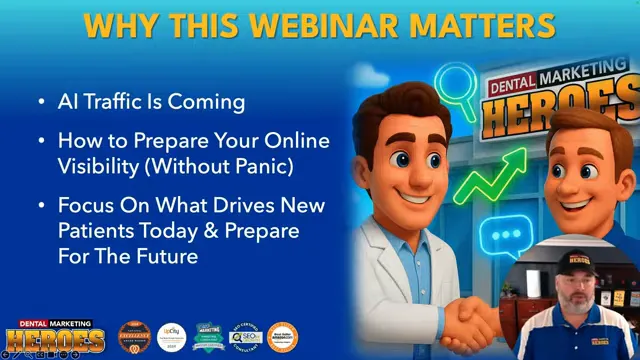
🤖 What is changing in search (and what AI Traffic means for dentists)
Search is evolving from a list of blue links to a more conversational, answer-first interface. Instead of a staggered list of websites, many people now see an AI-generated summary at the top of results — often with a short, conversational answer and referenced links. This is great for users because it speeds up the process of finding information. For local businesses it introduces both opportunity and risk:
- Opportunity: If AI pulls your authoritative content into that summary, you get visibility and trust. That can shorten the patient journey and increase conversions.
- Risk: If AI pulls inaccurate or competitor-sourced content, your practice could be overlooked.
Key takeaway: AI answers are aggregating content. They don’t invent everything from scratch — they pull information from places like websites, Google Business Profiles, review platforms, knowledge panels, and other data sources. That means there are things you can control.
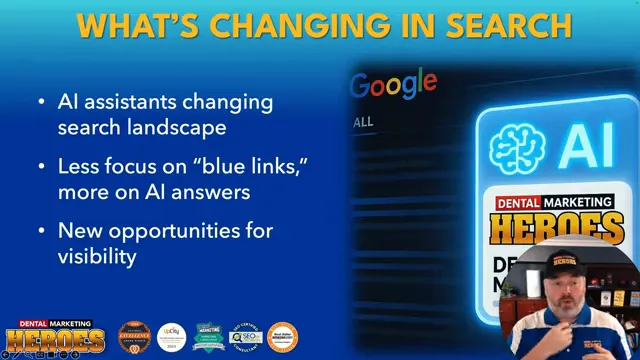
📊 Real data: How much AI traffic are dental websites actually getting?
There’s a lot of hype about AI “stealing” traffic. Let me ground that hype with real numbers from dental practices we manage or audit. These are live analytics snapshots that show the AI-sourced sessions compared to total sessions.
Example 1 (larger practice):
- Total sessions last month: ~11,000
- AI sessions last month: 58
- AI as % of total: less than 1%
- Primary AI sources: ChatGPT and Perplexity

Example 2 (smaller practice):
- Total sessions last month: ~2,500
- AI sessions last month: 12
- AI as % of total: ~0.5%
Example 3 (another local business):
- Total sessions: ~2,000 per month
- AI sessions last month: 25 (this broke 1% for that site) but is just 1.15% of total traffic
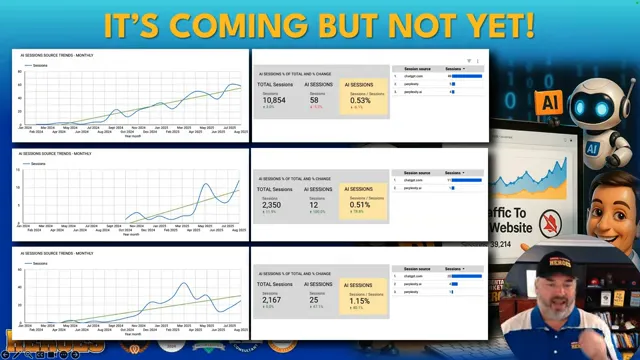
What this tells us:
- AI traffic is growing rapidly in percentage terms, but from a tiny base — which makes the growth curve look dramatic even though the absolute numbers are small.
- For most dental practices today, AI accounts for well under 1% of website sessions.
- This means — right now — you should focus first on what drives 99%+ of your traffic: organic SEO, local listings, paid search when needed, and conversion optimization.
In short: AI is a trend you must prepare for, but it is not a crisis that replaces proven fundamentals overnight.
📌 Why the sky isn’t falling (and the role of trusted local info)
There’s plenty of dramatic commentary out there: “SEO is dead,” “search as we know it is over,” etc. For some large, information-only websites that depend on ad revenue or clicks for monetization, AI could change the model significantly. For local service businesses — like dental practices — trusted local information still matters deeply.
Why?
- Patients choose providers, not websites. They rely on human signals — reviews, photos, staff tone, availability, and proximity — to make choices.
- Map results and local business profiles (Google Business Profile, Apple Maps, Bing) feed AI engines. If your local listing is strong, you’re more likely to be pulled into AI-produced answers.
- Human behavior changes slowly. Even when AI answers a basic question, humans often look for social proof and validation before making an appointment.
So the best defense — and offense — is to be the most trusted, visible, and consistent source of local dental information in your market.
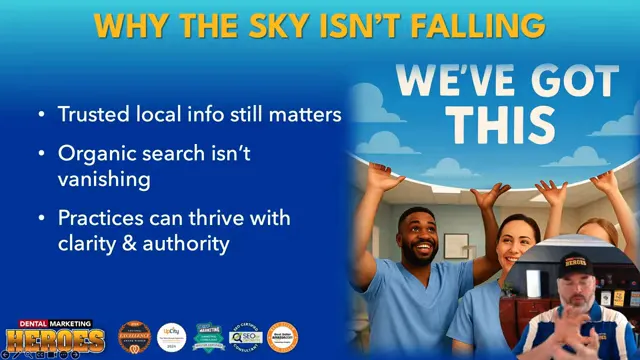
✅ Three foundations every dental practice must master now to keep attracting new patients with SEO and AI Traffic
Based on what I see working for dental clients, there are three non-negotiable pillars to prepare for AI and protect your marketing performance today:
1. Your website: clear, authoritative, and updated
Your website is the hub of everything. Too many practices treat their site like a brochure and leave it to stagnate for years. That’s a missed opportunity. AI needs high-quality, authoritative content to pull from — and so do patients.
Actionable website checklist:
- Audit for clarity and trust: Is your practice name, address, phone (NAP), hours, and services clear? Are provider bios written to build trust? Include photos and videos where possible.
- Technical SEO audit: Fix slow page speeds, mobile issues, broken links, structured data errors.
- Service pages and long-form content: Don’t be too lean. Explain procedures, expected outcomes, costs (estimates or ranges), treatment timelines, and FAQs on each service page.
- FAQ sections per service: These are gold for both search and AI. AI loves direct Q&A pairs.
- Schema markup: Implement structured data (JSON-LD) for local business, service, FAQ, provider, and review schema to help AI and search engines understand your content.
If you want help with an audit or to improve site conversions, see our resources:
- Website conversion tools: https://dentalmarketingheroes.com/website-conversion-helpful-tools/
- Dental web design best practices: https://dentalmarketingheroes.com/the-ultimate-dental-web-design-guide/
- Free dental website redesign checklist: https://dentalmarketingheroes.com/your-dental-website-redesign-checklist-for-2020/
2. Google Business Profile and local listings: own your local presence
Google Business Profile (GBP) is one of the primary data sources for local AI answers. If you haven’t claimed, verified, and optimized your GBP, fix that now.
Priorities for GBP and local listings:
- Claim and verify your Google Business Profile and keep your NAP consistent across listings
- Optimize every field: categories, attributes, business description, services, photos, and posts
- Use Google’s Q&A and seed commonly asked questions and answers
- List on other mapping platforms (Apple Maps, Bing) and major directories — AI can pull from non-Google sources too
- Review and update listings monthly — Google adds features regularly and staying current gives you an advantage
Need a deep dive? Check our articles:
- Optimize Google My Business: https://dentalmarketingheroes.com/optimizing-google-my-business-profile/
- Local SEO for dentists: https://dentalmarketingheroes.com/local-seo-for-dentists/
- Find the best dental SEO company: https://dentalmarketingheroes.com/find-the-best-dental-seo-company-for-your-practice/
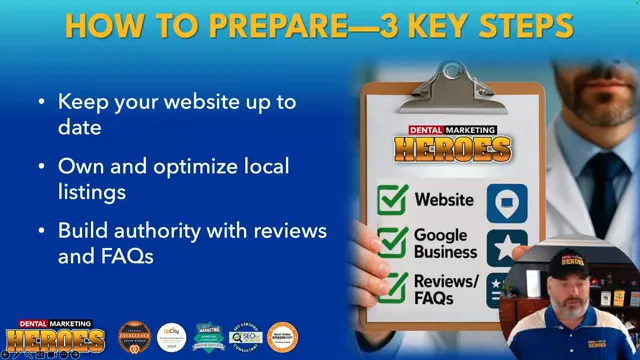
3. Reviews: a measurable trust engine
Online reviews are the modern word-of-mouth. AI engines ingest reviews from Google, Yelp, and other platforms. A strong review profile with a steady velocity of new reviews dramatically increases your chance of being the trusted answer for prospective patients.
Quick facts:
- Only about 6% of patients leave a review if not asked.
- A review strategy can dramatically increase the number of reviews and the speed at which they arrive.
- AI pulls review snippets that can show up in answers — more positive, relevant reviews increase trust in AI summaries.
Review request script for your front desk:
“Hi [Patient Name], we’re so glad your visit went well. Would you mind sharing your experience in a quick Google review? It helps us reach other patients like you. Here’s a QR code you can scan on your phone — it takes less than a minute.”
Other tips:
- Use a QR code or direct link to the review page
- Follow up with text or email within 24–48 hours
- Respond to every review — thank positive reviewers and professionally address complaints
- Consider a review management service if manual follow-up is inconsistent: https://dentalmarketingheroes.com/dental-marketing-services/get-more-online-reviews/
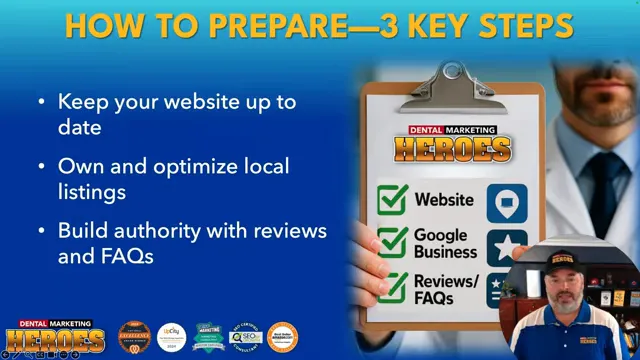
⛔ What NOT to do — avoid panic-driven mistakes
When a new technology arrives, there’s always noise: hacks, overnight “solutions”, and agencies promising magic. Don’t fall for the hype. Here’s what to avoid:
- Don’t chase AI “hacks” or copycat tactics from big-tech case studies that don’t apply to local practices
- Don’t abandon proven SEO — fundamentals still work and are the foundation for AI visibility
- Don’t buy sketchy services promising instant AI rankings — if it sounds too good to be true, it usually is
- Don’t make your website “lean” to the point of leaving out helpful content — clarity doesn’t mean brevity in all cases
Stay focused on sustainable strategies: produce helpful content, optimize local listings, and build social proof. Those moves are durable and will help you whether search remains link-based or becomes more AI-driven.
🛠 Practical action plan — what to do this month
Use this step-by-step action plan to move from uncertainty to momentum. You can implement most items yourself or hand them to a marketing partner. Prioritize the items in the order listed — that’s where you’ll see immediate return.
Week 1 — Quick wins (high impact, low effort)
- Claim and verify your Google Business Profile. Make sure the NAP is consistent with your website.
- Update hours, holiday hours, and emergency contact info.
- Generate a QR code that links directly to your Google review page and print a small card for the front desk.
- Respond to any recent reviews in a timely, professional way.
Resources:
- Google Business Profile optimization guide: https://dentalmarketingheroes.com/optimizing-google-my-business-profile/
- How to generate great dentist reviews: https://dentalmarketingheroes.com/how-to-generate-great-dentist-reviews/

Week 2 — Fortify your website (essential updates)
- Run a website clarity and technical audit (or request our free checkup): https://dentalmarketingheroes.com/free-dental-marketing-checkup/
- Add or expand service pages with FAQs. Example: create an FAQ block on dental implants, crowns, fillings, cosmetic services, hygiene visits, etc.
- Implement or review schema markup for services, FAQs, and local business data.
- Ensure contact forms and phone tracking are working correctly.
If your site is more than five years old or has poor navigation, book a website redesign consultation: https://dentalmarketingheroes.com/dental-marketing-services/dentist-web-design/
Week 3 — Content and local signal building
- Create a content calendar: 1–2 long-form blog posts per month focused on local queries (e.g., “Best dentist for implants in [your town]”, “How to handle a dental emergency after hours in [your town]”).
- Add FAQ content to your Google Business Profile and to each service page.
- Ensure you’re listed consistently across key directories (Apple Maps, Bing, major local directories).
- Start a simple patient referral program if you don’t have one: https://dentalmarketingheroes.com/patient-referral-new-patient-acquisition/
Long-form content and FAQs feed both SEO and AI engines. Each Q&A serves as a potential snippet AI can use. More importantly, they help potential patients make decisions.
Week 4 — Measurement and testing
- Set up Google Analytics and Search Console properly. Check which channel drives the most leads — SEO should be a top channel.
- Track AI traffic in your analytics and compare with other channels. Tools have improved; many now report AI-sourced sessions.
- If organic traffic isn’t the largest source of website visits, re-assess your SEO strategy: https://dentalmarketingheroes.com/dental-seo/
- Run a small ad test (Google Ads or Facebook/Instagram) to compare cost-per-lead with long-term SEO ROI.
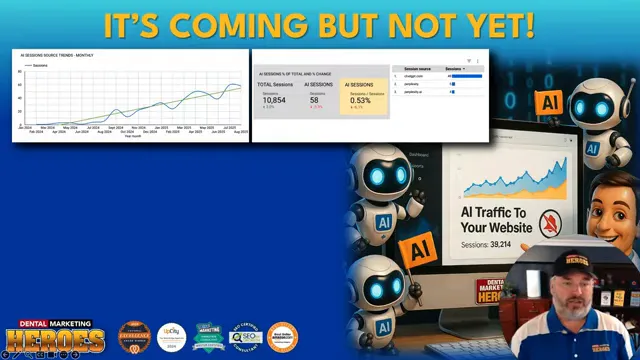
📈 Measuring success — what to track
To know if your changes work, you must measure. Track these KPIs monthly:
- Organic sessions (total and by service page)
- Local pack impressions and clicks (Google Business Profile insights)
- Review count, average rating, and review velocity (new reviews per month)
- Number of calls and contact form submissions (call tracking recommended)
- AI Traffic – AI-sourced sessions (now available in modern analytics tools) and any referral patterns from ChatGPT, Perplexity, Gemini, etc.
Remember: good SEO compounds. You won’t get immediate miracles, but consistent improvements produce sustainable growth over months and years. If you need help interpreting your metrics, see our guide on important SEO metrics: https://dentalmarketingheroes.com/what-are-the-most-important-seo-metrics-to-track/
🧩 Schema markup explained (plain language)
Schema is structured data you add to your website (typically JSON-LD) that tells search engines and AI tools what your content means. Think of it as labels on boxes in a warehouse — it helps systems find the right content for specific queries.
Useful schema types for dental practices:
- LocalBusiness / Dentist — for basic practice info
- Physician / MedicalBusiness — for provider details
- Service — to describe each dental service
- FAQ — question-and-answer pairs that AI loves
- Review — to mark up reviews and ratings
You don’t need to be a developer to implement schema — many website platforms and SEO plugins support it. Ask your developer or agency to ensure it’s implemented properly across service pages and FAQ sections. Proper schema increases the chance AI will surface your content as an authoritative answer.
🧯 Common staff scripts and templates To Generate More Reviews (front desk + follow-up)
To make review collection and patient communication consistent, train staff with short scripts. Consistency is the engine that drives review velocity and positive online reputation.
Front desk exit script:
“Thanks so much for coming in today, [Patient Name]. How was your visit?”
If positive: “That’s great to hear. Would you mind sharing that experience in a quick Google review? It helps other patients find our practice. Here’s a QR code — it’s super fast.”
Automated follow-up text/email (24–48 hours):
“Hi [Patient Name], thanks again for visiting [Practice Name]. If your experience was great, would you please leave a quick Google review? It helps us help more people in [Town/City]. [insert short link]”
Review response template (positive review):
“Thank you [Reviewer Name]! We’re so glad you had a good experience. Your feedback helps our team and other patients.”
Review response template (negative review):
“Hi [Reviewer Name], we’re sorry to hear about your experience. Your feedback matters — please call our office at [phone] so we can learn more and make it right.”
🔎 Case study takeaways — what the numbers taught us
From the examples earlier, here’s what to note as a practical, non-hype interpretation:
- Even when AI-sourced sessions show rapid percentage growth, the absolute volumes for dental sites remain tiny compared to organic traffic.
- If your organic SEO is strong, you’re already in a position of advantage because the same signals (authority, local relevance, quality content) feed AI results.
- Investing in review growth and GBP optimization gives immediate lifts in local visibility — for both traditional search and AI-derived answers.

🧭 Long-term strategy — prepare and adapt without panic
AI search will continue to evolve. Your long-term strategy should be to build durable assets that serve multiple purposes:
- Website content (service pages, guides, FAQs) that informs patients and feeds AI engines
- Google Business Profile completeness and frequent updates
- Consistent, high-quality reviews and reputation management
- Technical SEO and schema markup to make your content discoverable
- Measurement systems to track channels, conversions, and AI-sourced traffic
These assets protect you irrespective of how search interfaces evolve. They feed organic search, AI answer engines, paid campaigns, social channels, and even offline word-of-mouth.
🧾 Useful resources and next steps
If you want to dig deeper, here are some relevant resources from our site that match the steps above:
- Local SEO for dentists: https://dentalmarketingheroes.com/local-seo-for-dentists/
- The ultimate guide to dental SEO: https://dentalmarketingheroes.com/the-ultimate-guide-to-dental-seo-how-to-rank-your-practice-higher/
- How to generate great dentist reviews: https://dentalmarketingheroes.com/how-to-generate-great-dentist-reviews/
- Website conversion tools: https://dentalmarketingheroes.com/website-conversion-helpful-tools/
- Get a free dental marketing checkup: https://dentalmarketingheroes.com/free-dental-marketing-checkup/
- Free dental SEO report: https://dentalmarketingheroes.com/free-dental-seo-report/
- Sign up for a free discovery call and audit: https://dentalmarketingheroes.com/schedule-a-discovery-call/
- The dental marketing blog: https://dentalmarketingheroes.com/dental-marketing-blog/
❓ FAQ — Answers to your most common AI + SEO questions
Q: Will AI take away my website traffic and new patient leads?
A: Not right now. The data we’ve seen shows AI traffic to dental websites is minimal — well under 1% in most cases. That said, as AI improves, it may change how users navigate the funnel. The smart play is to focus on what works today (SEO, GBP, reviews) and augment your strategy for AI over time.
Q: Do I need to rebuild my website for AI search?
A: Usually no. Most dental websites don’t need a full rebuild. Instead, focus on updates: add detailed service pages, FAQs, schema markup, and ensure technical basics (speed, mobile, security) are done. If your site is very old or poorly structured, then a redesign might be warranted — but that’s often a parallel decision based on conversion goals.
Q: Should I change my SEO strategy because of AI?
A: You should augment, not replace. Good SEO will continue to help you rank and feed AI engines. Add AI-specific tactics: robust FAQ content, schema markup, and strong local signals (GBP and reviews). If your current SEO is weak, fix that foundation first.
Q: What’s the single best thing I can do this month to be more AI-ready?
A: Optimize and fully complete your Google Business Profile, and start generating more reviews. Those moves provide immediate local lift and directly feed many AI engines.
Q: Are there AI SEO hacks or companies I should avoid?
A: Beware anyone promising instant rankings or secret AI tricks. Ethical, transparent SEO that focuses on content quality, technical health, and local signals is the durable path. Avoid sketchy vendors who promise the moon.
Q: How do I know if AI is showing my practice to potential patients?
A: Modern analytics and reporting tools now surface AI-sourced sessions. You can also test manually: use AI platforms and search queries like “best dentist in [your town]” in an incognito or neutral setting. If you want a definitive check, request an SEO and AI visibility audit.
Q: Will reviews be more important with AI search?
A: Absolutely. AI pulls information from reviews and local listings. More high-quality reviews improve both your human and AI reputation.
Q: Will AI answer patient questions instead of sending them to my website?
A: For basic informational questions (e.g., “What is a cavity?”), AI may provide answers directly. For provider choice and booking, people still want validation — reviews, photos, staff impressions. So your website and GBP remain crucial.
Q: How often should I update my website and local listings?
A: Check and update local listings at least quarterly; check Google Business Profile monthly if possible. Publish fresh website content on a consistent schedule — ideally at least once or twice per month if you can, focusing on patient-centric topics and FAQs.
📣 Final thoughts — calm, practical, and strategic
AI traffic is a real trend — and you should prepare. But preparation is not panic: it’s clarity and consistent execution of fundamentals. Strengthen your website, dominate your local listings, and build a strong review profile. These moves shore up your marketing today and position you well for AI-driven search in the future.
If you’d like an objective view of where you stand, we offer free audits and discovery calls tailored to dental practices. A quick audit will tell you what to prioritize in the next 30, 60, and 90 days.
Ready to get started? Here are direct links to some resources and services we referenced:
- Free dental marketing checkup: https://dentalmarketingheroes.com/free-dental-marketing-checkup/
- Schedule a discovery call: https://dentalmarketingheroes.com/schedule-a-discovery-call/
- Get the Free Checklist called: ‘The 5 Vital Steps To Get Found In The New Era of AI Search Checklist’: https://link.sendlink.co/qr/A3DZEMYQkhCi
- Free dental SEO report: https://dentalmarketingheroes.com/free-dental-seo-report/
- Local SEO guide: https://dentalmarketingheroes.com/local-seo-for-dentists/
- Web design & conversion help: https://dentalmarketingheroes.com/the-ultimate-dental-web-design-guide/

Keep calm and market on — focus on the foundational tactics that attract real patients today, and layer AI-ready tactics on top. If you want a free audit or to talk through a plan for your practice, book a discovery call and we’ll walk you through a no-pressure, practical roadmap.
Thanks for reading — and for taking the steps to protect and grow your practice in the AI era.
GET YOUR FREE DENTAL MARKETING EBOOK |
7 Steps To Dental Practice Marketing Success |
| DOWNLOAD NOW! |

